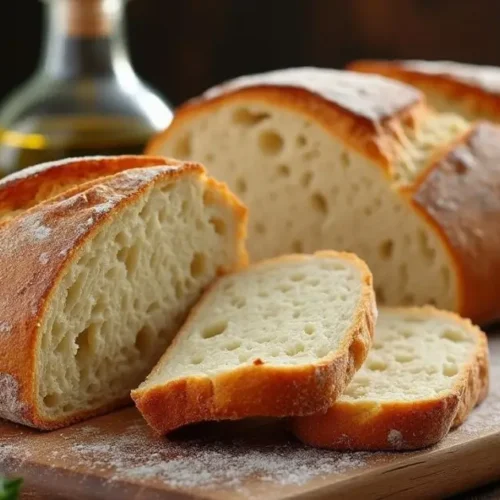
Crusty Italian Bread Recipe That’s Simply Perfection
There’s nothing quite like the aroma of freshly baked bread wafting through your kitchen. This crusty Italian bread recipe brings the charm of a rustic bakery straight to your home.
Ingredients
- Core Ingredients
- Bread Flour 3 ½ cups: Essential for a sturdy structure and that chewy, rustic texture.
- Active Dry Yeast 2 ¼ teaspoons: Helps the dough rise to perfection, creating an airy crumb.
- Warm Water 1 ½ cups: Activates the yeast and ensures a smooth, pliable dough.
- Salt 2 teaspoons: Balances the flavors and enhances the bread’s natural taste.
- Sugar 1 teaspoon: Feeds the yeast for optimal fermentation and adds a subtle hint of sweetness.
- Olive Oil 1 tablespoon: Adds richness and keeps the dough soft during shaping.
- Optional Add-Ins
- Fresh Rosemary or Thyme: For a fragrant herby twist.
- Sesame Seeds or Poppy Seeds: Sprinkle on top for added texture and flavor.
Instructions
- Prepare the Dough
- In a large mixing bowl, combine 3 ½ cups of bread flour, 2 ¼ teaspoons of active dry yeast, and 2 teaspoons of salt. Mix well to distribute the dry ingredients.
- Add 1 ½ cups of warm water (around 100°F or 38°C) and 1 teaspoon of sugar to activate the yeast. Stir until the mixture forms a shaggy dough.
- Drizzle in 1 tablespoon of olive oil, and use a wooden spoon or your hands to mix until the dough comes together.
- Knead the Dough
- Transfer the dough onto a lightly floured surface. Knead it for 8–10 minutes until it’s smooth and elastic. If the dough feels sticky, sprinkle a little more flour, but avoid overloading it.
- First Proofing
- Shape the dough into a ball and place it in a lightly greased bowl. Cover with a clean kitchen towel or plastic wrap.
- Let it rise in a warm, draft-free spot for 1–2 hours, or until it doubles in size.
- Shape the Dough
- Punch down the risen dough to release air bubbles. Turn it out onto a floured surface, and shape it into a round loaf or an elongated oval.
- Second Proofing
- Place the shaped dough onto a piece of parchment paper or in a proofing basket. Cover it again and let it rise for another 30–40 minutes, until it puffs up slightly.
- Preheat and Prepare the Oven
- Preheat your oven to 450°F (232°C). If using a Dutch oven, place it inside the oven to heat up for at least 30 minutes.
- To create steam (if not using a Dutch oven), place a pan of hot water on the bottom rack of your oven.
- Bake the Bread
- Carefully transfer the dough (with parchment paper, if used) into the preheated Dutch oven. If baking on a sheet, place it directly on the center rack.
- Cover the Dutch oven with its lid and bake for 25 minutes.
- Remove the lid and bake for an additional 10–15 minutes until the crust turns golden brown.
- Cool and Enjoy
- Transfer the bread to a cooling rack and let it cool for at least 20 minutes before slicing. This allows the interior to set properly and makes slicing easier.
- Tips for Success
- Score the Dough: Use a sharp knife to make a shallow slash on the top of the loaf before baking. This allows it to expand beautifully in the oven.
- Check for Doneness: Tap the bottom of the loaf—it should sound hollow when fully baked.
- Storage: Wrap leftovers in a clean kitchen towel or store in a bread box to maintain freshness.